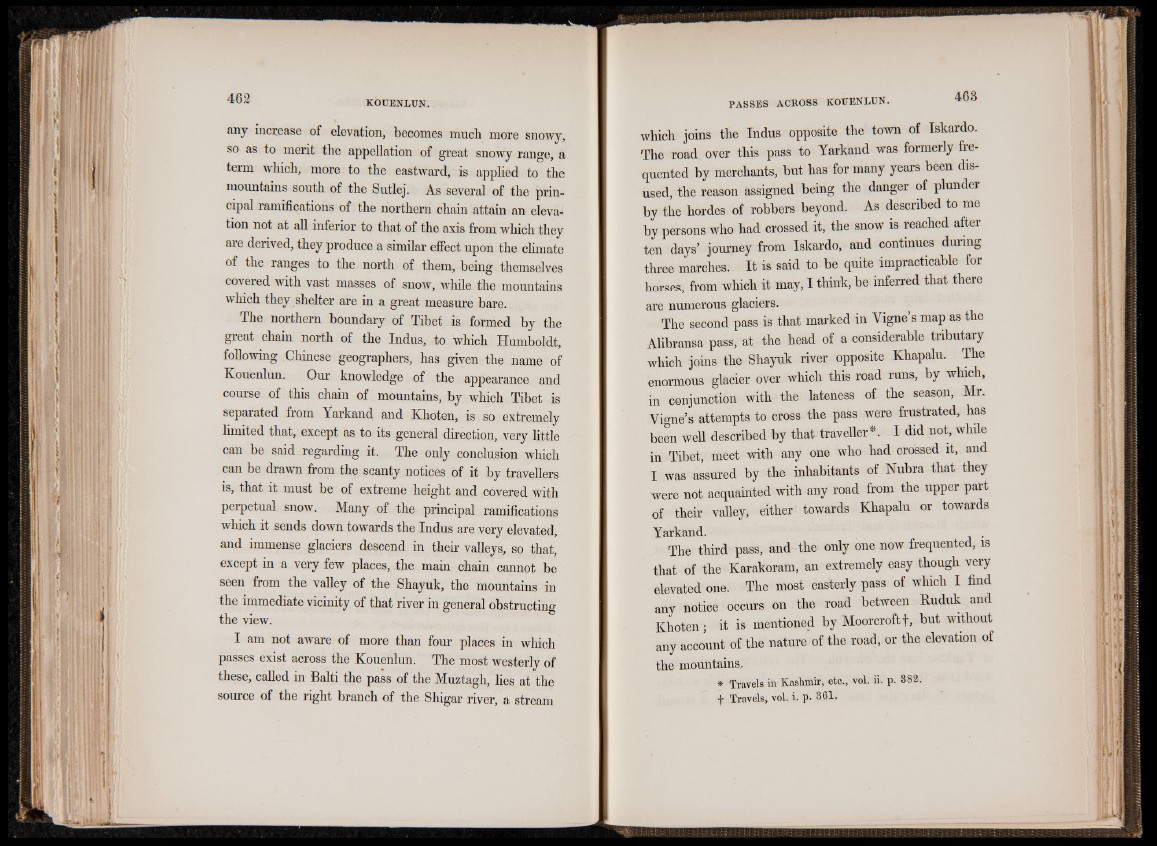
any increase of elevation, becomes much more snowy,
so as to merit the appellation of great snowy range, a
term which, more to the eastward, is applied to the
mountains south of the Sutlej. As several of the principal
ramifications of the northern chain attain an elevation
not at all inferior to that of the axis from which they
are derived, they produce a similar effect upon the climate
of the ranges to the north of them, being themselves
covered with vast masses of snow, while the mountains
which they shelter are in a great measure bare.
The northern boundary of Tibet is formed by the
great chain north of the Indus, to which Humboldt,
following Chinese geographers, has given the name of
Kouenlun. Our knowledge of the appearance and
course of this chain of mountains, by which Tibet is
separated from Yarkand and Khoten, is so extremely
limited that, except as to its general direction, very little
can be said regarding it. The only conclusion which
can be drawn from the scanty notices of it by travellers
is, that it must be of extreme height and covered with
perpetual snow. Many of the principal ramifications
which it sends down towards the Indus are very elevated,
and immense glaciers descend in their valleys, so that,
except in a very few places, the main chain cannot be
seen from the valley of the Shayuk, the mountains in
the immediate vicinity of that river in general obstructing
the view.
I am not aware of more than four places in which
passes exist across the Kouenlun. The most westerly of
these, called in Balti the pass of the Muztagh, lies at the
source of the right branch of the Shigar river, a stream
which joins the Indus opposite the town of Iskardo.
The road over this pass to Yarkand was formerly frequented
by merchants, but has for many years been disused,
the reason assigned being the danger of plunder
by the hordes of robbers beyond. As described to me
by persons who had crossed it, the snow is reached after
ten days’ journey from Iskardo, and continues during
three marches. It is said to be quite impracticable for
horses, from which it may, I think, be inferred that there
are numerous glaciers.
The second pass is that marked in Vigne’s map as the
Alibransa pass, at the head of a considerable tributary
which joins the Shayuk river opposite Khapalu. The
enormous glacier over which this road runs, by which,
in conjunction with the lateness of the season, Mr.
Vigne’s attempts to cross the pass were frustrated, has
been well described by that traveller*. I did not, while
in Tibet, meet with any one who had crossed it, and
I was assured by the inhabitants of Nubra that they
were not acquainted with any road from the upper part
of their valley* either towards Khapalu or towards
Yarkand.
The third pass, and the only one now frequented, is
that of the Karakoram, an extremely easy though very
elevated one. The most easterly pass of which I find
any notice occurs on the road between Ruduk and
Khoten; it is mentioned by Moorcroftf, but without
any account of the nature of the road, or the elevation of
the mountains,
* Travels in Kashmir, etc., vol. ii. p. 382.
f Travels, vol. i. p- 361.